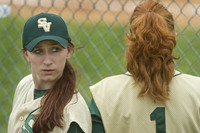As I've said before, I'm a voracious reader. I like reading most types of fiction, even if they are young adult or middle grade-- especially if they deal with subjects that interest me as a researcher, which include kids and competition in afterschoool activities like athletics and dance. Stories about young performers seem to particularly resonate, and two new books out about teenage musicians are worth a read. Allegra by Shelley Hrdlitschka and The Lucy Variations by Sara Zarr both focus on teenage female musicians who have crushes on older male teachers and who read Alice Munro short stories. Strange overlaps, huh? But the stories themselves are quite different. The eponymous Allegra attends a performing arts high school; she is most interested in dance but she has a strong background in music thanks to her musician parents. When she must take a music composition course her life heads in a new direction, mostly because of said romantic feelings about a teacher.
My biggest issue with Allegra was that I found the story ended rather abruptly given the serious issues raised by depression and leaving school due to sexual allegations and a form of bullying. The school Allegra attends in Canada doesn't seem nearly as competitive as other performing arts high schools I have read about and seen, as many students seem to collaborate across their artistic fields (visual arts, dance, music, etc.), but that doesn't stop feelings of jealousy between friends causing serious fallout for both teens and adults.
Unlike in Allegra, competition is front and center in The Lucy Variations. For the eponymous Lucy though this competition is organized and not between peers. Lucy and her younger brother Gus are considered prodigies on the piano competition and festival circuit. Lucy abruptly left the circuit eight months before the story begins after her grandmother passes away. The story focuses on her return to playing as she learns to balance attending school full-time (and not being tutored or attending a music academy) and a social life. And, again, those feelings for an older male teacher. The Lucy Variations has a great deal of layered nuance, along with an air of mystery that surrounds all of the characters (both central, like grandpa, and more tertiary, like Aruna). I seriously devoured the book in a few hours and loved the insight provided by Zarr about the impacts of serious levels of obscure fame and competition on teens.
The three main observations about competition that I found apply to many kids across competitive activities include: 1) Grandpa's attitude described on page 14 that "everyone is the competition" even if the child doesn't agree. 2) Reyna, Lucy's best friend, when she observes that, "You miss having an audience." Reyna thinks that Lucy seeks out attention in all aspects of life because she has become so used to performing and having people watch her from a young age. 3) Teacher Will's confession about young prodigies who grow up and find, "We grow up, and we aren't so special anymore." This is one of the most difficult things that haunt those who excel earlier in various endeavors, even on a small scale, because their identities are so wrapped up in being the best and always doing well.
Both stories will interest young readers who are piano players or musicians themselves, though I think The Lucy Variations will also appeal to those who have no other interest in music and who are interested in being enveloped by a good story. I love that YA novels cover these sorts of topics and I look forward to reading more books like these soon.






